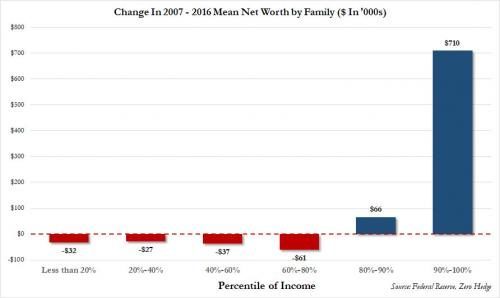Steve Bull's Blog, page 1275
October 26, 2017
Global Climate Change & Its Link to Soil Organisms

GLOBAL CLIMATE CHANGE & ITS LINK TO SOIL ORGANISMS
When people think of the consequences of global warming, most jump to the melting ice caps and death of beloved polar bears. We know that as our Earth undergoes climate change, it’s adversely affecting the ecological balance in complex ways. For the first time, however, a study done at the University of California Berkley, has linked climate change to the downfall of microbial species that are considered essential to ecological systems. Previous studies have identified the use of chemicals as harmful for soil organisms, insects, and birds, but never has climate change been pinpointed as a threat to these species.
The study states that “models predict that up to 30% of parasitic worms are committed to extinction, driven by a combination of direct and indirect pressures.” With this, species that are adapting to the climate change will allow them to “invade and replace” native organisms resulting in unpredictable, but most likely negative consequences.
Dr. Colin Carlson is the lead author of the study and estimates that we will see a huge extinction rate within the soil organisms as time and climate change continues. He blames this effect on the loss of habitat and the implications of trying to coexist. The end result of this could be detrimental to the human species, requiring lively soil to live.
Carlson explains that the effect of climate change on soil organisms has gone unnoticed for so long because our research focuses on the impact of the change on animals like vertebrates. Most people see microbial organisms as pests, rather than a crucial part of the ecological system. Since the modernization of agriculture, we have seen soil as a medium for holding plants, as Jenny Hopkins, author of “Can American Soil Be Brought Back To Life”, likes to put it.
…click on the above link to read the rest of the article…
Why the Rule of Law Matters, Even If It Doesn’t Exist
Hayek uses the sixth chapter of The Road to Serfdom to discuss the concept of the rule of law.
Young Americans like myself have come of age in a climate where arbitrary rule has steadily become the norm. Civil liberties, once guaranteed by the Bill of Rights, are now conditional; they are regularly disregarded in the pursuit of a specific end.
The war on terror, for example, ushered in an era where the government was given the power, or rather gave itself the power, to do anything it needed in order to keep the country secure. As long as the state’s violations against our inalienable rights were done in the name of national security, or prosperity, they were considered just, necessary even.
The Constitution that was specifically intended to protect the American people against this kind of rule has now just become a list of suggestions. President Bush is even rumored to have referred to it as a “goddamn piece of paper,” when confronted about his refusal to act within its bounds during the height of the War on Terror.
And in the wake of this “anything goes” rhetoric, the War on Terror was and continues to be used to suspend free speech, restrict travel, detain American citizens indefinitely, and even defend the American President’s use of a “secret kill list.”
Hayek and the rest of the world watched Hitler rise to power through legal means.
It was with this jaded view of government restraint that I began reading the Sixth Chapter of The Road to Serfdom. Hayek uses this chapter to dig into the concept of the rule of law.
…click on the above link to read the rest of the article…
Small Nuclear Reactors, a 50s Nightmare Come Back to Haunt Us

Photo by Neil H | CC BY 2.0
It’s easy to see why Rolls Royce and other companies in the nuclear engineering business are pushing the UK government finance the development a new generation of ‘small modular reactors’ or SMRs. Whether the project succeeds or fails, there are juicy profits to be had for them at taxpayers expense.
Rather harder to understand is why the government should see the slightest merit in the idea.
According to a recent report by Rolls-Royce and its partners in the ‘SMR Consortium’ (SMRC), a UK SMR program could create 40,000 skilled jobs, contribute £100 billion ($132 billion) to the economy and open up a potential £400 billion global export market.
Nuclear Industries Association chairman Lord (John) Hutton claims in the foreword that a UK SMR programme could “help the UK become a vibrant, world-leading nuclear nation.” He asserts his belief that “it is fundamental for the UK to meet its 2050 decarbonisation targets and will deliver secure, reliable and affordable electricity for generations to come.”
The SMRC report envisages an approximate doubling of the UK’s 9.5 GW existing nuclear capacity by 2030, then another doubling by 2050 to around 40GW. That implies that come 2050, SMRs would be delivering some 30GW – the output of 100 300MW units scattered around the UK.
There are just two problems with the rosy scenario. First, the techno-optimism that oozes from every page is a fantasy. Nuclear power stations have got bigger to achieve economies of scale: it’s much cheaper to build a single 1.2GW unit than four 300MW units, or a dozen 100MW units.
As an illustration of the principle, take a look at the wind power industry. One of the main reasons why offshore wind has come down so much in cost is the move to ever-larger wind turbines. A single new 8MW turbine may now be bigger than an entire wind farm of 20 years ago.
…click on the above link to read the rest of the article…
NYT’s Assault on Press Freedom
Exclusive: The New York Times, which once postured as the champion of a free press, now is seeking crackdowns on news that the public gets from the Internet under the guise of combatting “Russian propaganda,” explains Daniel Lazare.
Once upon a time the danger to a free press came from the right. But since Russia-gate, liberals have been busy playing catch-up.

The New York Times building in Manhattan. (Photo credit: Robert Parry)
The latest example is a front-page article in Tuesday’s New York Times. Entitled “YouTube Gave Russian Outlet Portal Into U.S.,” it offers the usual blah-blah-blah about Kremlin agents engaging in the political black arts. But it goes a step farther by attempting to discredit a perfectly legitimate news organization.
Reporters Daisuke Wakabayashi and Nicholas Confessore begin by noting that RT, the Moscow-funded TV channel formerly known as “Russia Today,” is now an Internet powerhouse and then observes that when it became the first YouTube news channel to surpass one million views, YouTube Vice President Robert Kyncl “joined an RT anchor in a studio, where he praised RT for … providing ‘authentic’ content instead of ‘agendas or propaganda.’”
Cue the ominous background music. “But now,” the article continues, “as investigators in Washington examine the scope and reach of Russian interference in United States policy, the once-cozy relationship between RT and YouTube is drawing closer scrutiny.”
Why? Because RT took advantage of its “prominent presence on YouTube’s search results” to pepper viewers with negative videos about Hillary Clinton. According to Wakabayashi and Confessore:
“As the presidential election heated up in the spring of 2016, RT consistently featured negative stories about Mrs. Clinton, according to United States intelligence officials. That included claims of corruption at her family foundation and ties to Islamic extremism, frequent coverage of emails stolen by Russian operatives from Mrs. Clinton’s campaign chairman, and accusations that she was in poor physical and mental health.”
…click on the above link to read the rest of the article…
October 25, 2017
Here’s You and Here’s the Top Ten Percent
 In a nutshell, here is a graph that summarizes everything you need to know about the unsustainable US economy. Unless you’re in the top ten percent of income producers in the nation — or, at least, living in their neighborhood — you are living in a dingy bedroom economy that has only seen its net worth decline since the Great Recession began. Those who are in the top ten percent, on the other hand, profited astronomically from the Great Recession. It’s the best thing that ever happened to them, and you helped them do it with tax-backed or even tax-funded bailouts and by allowing them a perpetual cycle of savings on their capital gains.
In a nutshell, here is a graph that summarizes everything you need to know about the unsustainable US economy. Unless you’re in the top ten percent of income producers in the nation — or, at least, living in their neighborhood — you are living in a dingy bedroom economy that has only seen its net worth decline since the Great Recession began. Those who are in the top ten percent, on the other hand, profited astronomically from the Great Recession. It’s the best thing that ever happened to them, and you helped them do it with tax-backed or even tax-funded bailouts and by allowing them a perpetual cycle of savings on their capital gains.Clearly the only ones who “recovered” are at the top
Insanity is repeating the same thing over and over and expecting different results
Now you can see how those bailouts have trickled down to you as well as how capital-gains tax breaks have trickled down. Are you now going to go for Trump’s third-and-greatest-ever round of trickle-down economics?
Lower taxes for corporations may be a good idea (why tax the economic engines and rob them of fuel) if they also come with the end of loopholes (corporate welfare) and with a provision that the corporation cannot be engaged in any corporate buybacks during that tax year or the following. (Without that provision, lower corporate taxes will just fuel useless stock buybacks, making the rich richer, but doing nothing to grow the corporation and grow jobs).
Capital-gains tax breaks, on the other hand, have always been a terrible idea. The notion that such breaks cause people to reinvest their tax savings into creating new factories and jobs is not only proven wrong by thirty-plus years of history (see chart above for just the last decade of decline), but it is ludicrous in concept (even without historic proof):
…click on the above link to read the rest of the article…
The myth of a nuclear-free Austria
 Since Austria passed a law banning the importation of nuclear electricity in 2015 it has claimed to be 100% nuclear-free. But 25% of the electricity Austria imports and over 8% of the electricity it consumes is still of indisputably nuclear origin. Austria’s claim to be 100% nuclear-free is either deliberate misrepresentation or an implicit admission that the Austrian government has no idea how Europe’s electricity grid works. (Inset: Austria’s Zwentendorf nuclear plant. Completed in 1978. Never put into operation. Now a museum.)
Since Austria passed a law banning the importation of nuclear electricity in 2015 it has claimed to be 100% nuclear-free. But 25% of the electricity Austria imports and over 8% of the electricity it consumes is still of indisputably nuclear origin. Austria’s claim to be 100% nuclear-free is either deliberate misrepresentation or an implicit admission that the Austrian government has no idea how Europe’s electricity grid works. (Inset: Austria’s Zwentendorf nuclear plant. Completed in 1978. Never put into operation. Now a museum.)
In the recent Apple, Google, and how not to go 100% renewable post I described how Apple and Google were gaming the system to claim that they are powered by 100% renewables when in reality they are nowhere close. But gaming the system isn’t confined to business corporations (or the Dutch Railways). Austria does it too, but with a twist. Instead of purchasing “Guarantees of Origin” (GOs) to pretend that it’s bringing renewable energy in, Austria purchases them to pretend that it’s keeping nuclear energy out.
First a little history. In December 1978 the Austrian Parliament voted in favor of a ban on nuclear fission until March 1998, in July 1997 it unanimously passed legislation to remain a nuclear-free country, and since then it has embarked on a crusade to make the rest of Europe nuclear-free too. In 2011 it threatened to file suit to shut down nuclear plants in the Czech Republic and Slovakia, and in the same year it did file suit to shut down Slovakia’s Mochovce plant. In 2014 Austria threatened to use “all political and legal means” to stop construction of a nuclear waste dump in the Czech Republic. In 2015 it sued the UK in an attempt to stop Hinkley Point, and just recently it filed another suit to stop the expansion of the Paks nuclear plant in Hungary. Why is Austria suing everybody? Why can’t it mind its own business?
…click on the above link to read the rest of the article…
NPR, the CIA and Corporatism

Photo by Todd Huffman | CC by 2.0
In her five-minute interview with Ursula Wilder, a CIA psychologist whose job there is debriefing returning spies, NPR’s Mary Louise Kelly (their alleged National Security Correspondent) spoke of what makes someone who reveals state secrets tick. Kelly failed big-time to probe Wilder about whether she ever thought an insider might ever have a patriotic motivation to inform the public of illegal behavior on the part of the agency. Based on Wilders’ profile of leakers, the answer would surely have been No, but it sure would have been nice to ask.
Instead, the official story is simple. Each and every leaker, Wilder maintained, suffers from some DSM psychopathy, such as impulsiveness, narcissism or drug addiction, often compounded by exigencies such as marital discord or gambling debts. Leaks all stem from character defects, Wilder says—and Kelly doesn’t contradict—not to blowback by thwarted careerists or misdeeds the agency wants to disappear. She also neglected to point out that leaks should only happen when authorized by superiors, but Kelly didn’t ask about that kind either.
Wilder’s job description implies she treats agents for PTSD but she probably doesn’t admit to it. Wants the world to think they’re all so well motivated, trained, equipped, and managed as to be impervious to shock and awe. If they’re stressed, it’s likely that their personal lives are out of control, their problems self-inflicted. Any time you have a problem with power, the problem is you. Hear for yourself.
…click on the above link to read the rest of the article…
Europe: Journalists Against Free Speech
Gone is all pretense that journalism is about reporting the facts. These are the aims of a political actor.
Being bought and paid for by the EU apparently counts as “press freedom” these days.
According to the guidelines, journalists should, among other things, “Provide an appropriate range of opinions, including those belonging to migrants and members of minorities, but… not… extremist perspectives just to ‘show the other side’…. Don’t allow extremists’ claims about acting ‘in the name of Islam’ to stand unchallenged…. where it is necessary and newsworthy to report hateful comments against Muslims, mediate the information.”
The European Federation of Journalists (EJF), “the largest organization of journalists in Europe, represents over 320,000 journalists in 71 journalists’ organizations across 43 countries,” according to its website. The EJF, a powerful player, also leads a Europe-wide campaign called “Media against Hate.”
The “Media against Hate” campaign aims to:
“counter hate speech and discrimination in the media, both on and offline… media and journalists play a crucial role in informing…policy … regarding migration and refugees. As hate speech and stereotypes targeting migrants proliferate across Europe… #MediaAgainstHate campaign aims to: improve media coverage related to migration, refugees, religion and marginalised groups… counter hate speech, intolerance, racism and discrimination… improve implementation of legal frameworks regulating hate speech and freedom of speech…”
Gone is all pretense that journalism is about reporting the facts. These are the aims of a political actor.
A very large political actor is, in fact, involved in the “Media against Hate” campaign. The campaign is one of several media programs supported by the EU under its Rights, Equality and Citizenship Programme (REC). In the REC program for 2017, the EU Commission, the EU’s executive body, writes:
…click on the above link to read the rest of the article…
MARKETS… WE GOT TROUBLE: Debt & Brain-Dead Retail Investors Prop Up Stocks
As the Dow Jones Index hits another all-time high today, smart money is rushing to the exits. You see, smart money knows when something is too good to be true. Unfortunately for the retail investor who is suffering from acute BRAIN DAMAGE, they are doing quite the opposite. As institutions sellout on each new market price rise, retail investors are happily buying… hand over fist.
And why shouldn’t they? These are good times. Well, maybe not for Americans living in Houston, parts of Florida, California or in Puerto Rico. Whatever happened to the news on the massive flooding and hurricane damage in Houston, Florida and Puerto Rico? I remember seeing videos of Miami Beach High-Rise Condos with seawater 5-8 feet surrounding the entire area. Does anyone have an idea of what happens to electrical systems when salt water floods buildings? It’s not good.
Regardless… the amount of destruction major U.S. cities have experienced in the past three months is like nothing we have witnessed before. Regrettably, a lot of these homes and businesses will never be rebuilt. Not only don’t we have the money to do it, more importantly, we also don’t have the available energy. While the massive destruction by hurricanes, flooding and fire have not impacted the stock market currently, they will.
As I mentioned at the beginning of the article, retail investors are propping up the markets. However, they aren’t the only ones, or should I say, the only factor in keeping the markets from falling off a cliff. Thanks to Uncle Sam, total U.S. debt has increased by $590 billion in just the past month and a half. Here is a table of U.S. debt from the data published by the fine folks at TreasuryDirect.gov:
…click on the above link to read the rest of the article…
Falling Interest Rates
Amassing Unproductive Debt
Last week, we discussed the marginal productivity of debt. This is how much each newly-borrowed dollar adds to GDP. And ever since the interest rate began its falling trend in 1981, marginal productivity of debt has tightly correlated with interest. The lower the interest rate, the less productive additional borrowing has in fact become.
 Left: the first IKEA store located in Älmhult in Sweden, near the residence of the company’s founder (nowadays the store is a museum); right: a Task Rabbit car. Given the valuations at which TaskRabbit was able to raise funds recently, it is a good bet IKEA paid a small fortune to take it over (waiting for the QE-induced bubble to burst may have been cheaper). [PT]
Left: the first IKEA store located in Älmhult in Sweden, near the residence of the company’s founder (nowadays the store is a museum); right: a Task Rabbit car. Given the valuations at which TaskRabbit was able to raise funds recently, it is a good bet IKEA paid a small fortune to take it over (waiting for the QE-induced bubble to burst may have been cheaper). [PT]
Let’s look at a recent event: the Ikea acquisition of TaskRabbit. You might wonder, why does a home goods company need to own a freelance labor company? Superficially, it seems to makes sense. Ikea products notoriously come in flat packs, but consumers don’t want to fuss with all the little parts. They just want finished furniture. Ikea has been using TaskRabbit to hire people to assemble it in their homes.
Isn’t this like that caricature of the billionaire who buys, say, the Planters Peanut company because he likes to eat salted nuts? Ikea could be a customer of TaskRabbit, hiring its temporary workers as needed, without owning the company. In fact, it had been doing that for years.
The acquisition price was not disclosed, however, we can guess that it was high. TaskRabbit was a Silicon Valley darling with a bright future. Its value proposition is right for this economy. It had raised $50 million, presumably at rich valuation multiples.
…click on the above link to read the rest of the article…



